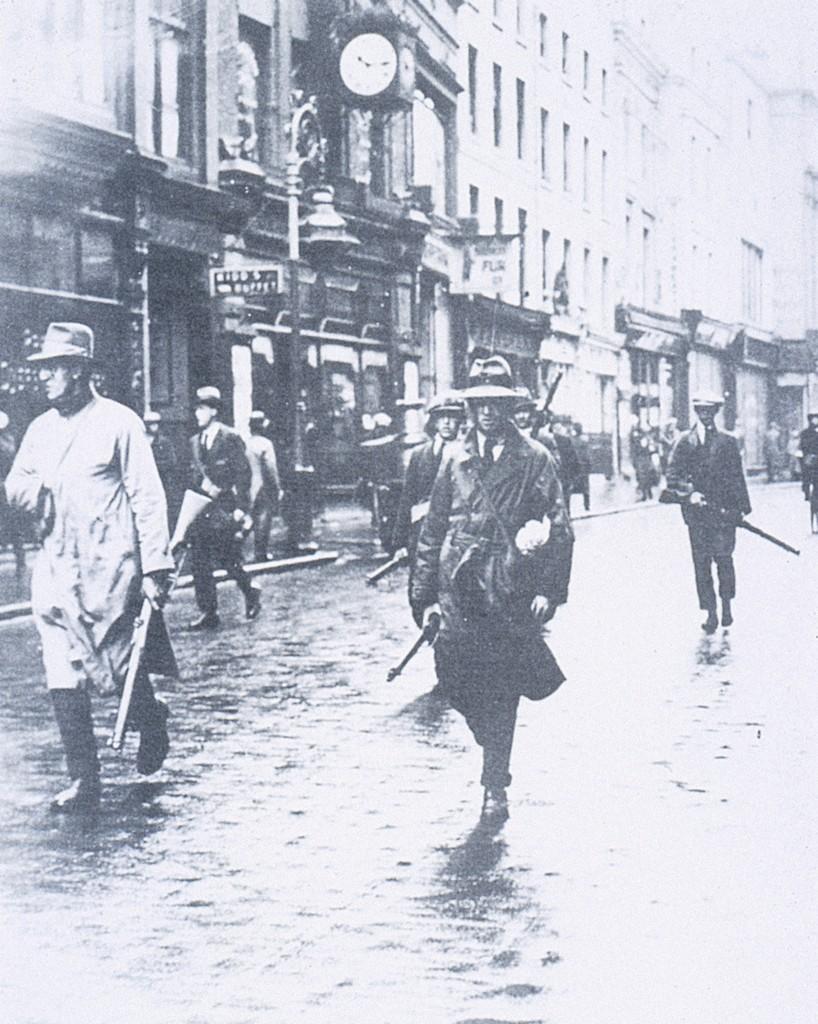The Battle of Four Courts, also known as the Four Courts Incident, was a pivotal event in Irish history that occurred during the Irish Civil War. The conflict began in June 1922, when the Irish government, led by Michael Collins, attempted to suppress the activities of the anti-treaty forces, who opposed the Anglo-Irish Treaty that had established the Irish Free State. The battle took place in Dublin between June 28 and July 5, 1922, and destroyed the Four Courts, a significant historical and cultural site in Ireland.
The Four Courts was a complex of buildings that served as the seat of the Irish judiciary. It was a symbol of Irish legal and constitutional authority and had been occupied by the anti-treaty forces since April 1922. The government viewed the occupation as a direct challenge to its authority and decided to take action to regain control of the building. The Four Courts were garrisoned by over 100 men, all armed with small arms. In anticipation of the Provisional Government’s assault on the Anti-Treaty IRA, the IRA began to dig in, mining the surrounding area and barricading entrances. The Four Courts now resembled a fortress, rather than grand courthouses. Barbed wire was laid down to impede any attempt to attack, firing positions were manned by men with rifles, and a few Lewis machine guns were also amongst the Anti-Treaty IRA’s arsenal.
On June 28, 1922, the Irish government launched an attack on the Four Courts. The attack was led by Irish Free State Army troops under the command of General Eoin O’Duffy. The Provisional Forces began their siege with a heavy bombardment of static weapons, which was overall ineffective. The anti-treaty forces, led by Cathal Brugha, responded with heavy resistance, and the battle quickly escalated into a full-scale conflict, there were other notable political leaders of the IRA on the ground such as Ernie O’Malley and Oscar Traynor. Despite their notable positions, they were foot soldiers like any other IRA member. The fighting lasted for several days, with both sides suffering heavy casualties. The anti-treaty forces were eventually defeated, and the Four Courts were heavily damaged by artillery fire. Although fighting lasted a few days and both sides lost men, the day-to-day average Dubliner was the one who truly suffered. On the first day, there are articles that mention that four civilians were confirmed killed by crossfire and an estimated 15 combatants slain in total.
The Battle of Four Courts had significant repercussions for the Irish Civil War and Irish history more broadly. It marked a turning point in the conflict and led to the eventual defeat of the anti-treaty forces. The battle also had a lasting impact on Irish culture and identity. The destruction of the Four Courts, a symbol of Irish legal and constitutional authority, was seen by many as a tragic loss for Irish nationalism.

The Battle for the Block
During the Battle of Four Courts, in the neighboring area colloquially known as “the Block” fighting also raged on. Before the hostilities began, the IRA took up defensive positions in over 10 of the buildings along “the Block.” The garrisons were armed with small arms and provisions to withstand an assault or siege launched by the Provisional Government and or British Forces. The “Block” spanned over three streets, the most notable being O’Connell Street, these streets would become the epicenter of fighting after the Four Courts fell. The soldiers that were stationed in the Block were now facing the same situation that their comrades faced earlier at Four Courts. The Irish Republican Army was now outgunned and outmanned by the Provisional Government. The Provisional Government bombarded the neighborhood with 6 lbs guns, instilling panic amongst the Irish Republican Army’s ranks. The Provisional Government used three armored cars to assault the Block, and the Irish Republican Army had no heavy ordinance to combat that armored vehicles. That plus the artillery pieces shifted the advantage in the Provisional Government’s favor.
The battle also had a significant impact on the development of the Irish state. The government’s decision to use force against the Four Courts was controversial and divisive and led to a deepening of political divisions within the country. The aftermath of the battle saw the establishment of a more authoritarian regime in Ireland, which was marked by the suppression of political dissent and the use of state violence against perceived opponents. This can also attribute to the turbulent remainder of the century Ireland still had instore, with constant infighting between religious sects and ideologies.
In conclusion, the Battle of Four Courts was a significant event in Irish history that had far-reaching consequences for the development of the Irish state and Irish culture. The conflict marked a turning point in the Irish Civil War and led to the eventual defeat of the anti-treaty forces. The battle also had a lasting impact on Irish identity and nationalism and was a source of controversy and division within the country for many years to come.
Citations
Fewer, M. (2019). THE BATTLE OF THE FOUR COURTS, 28–30 JUNE 1922. History Ireland, 27(4), 44–47. https://www.jstor.org/stable/26853089
Foster, G. (2006). In the Shadow of the Split: Writing the Irish Civil War. Field Day Review, 2, 294–303. http://www.jstor.org/stable/30078650
RTE.ie History. (2022, June 15). The Battle of Dublin. RTE. https://www.rte.ie/history/battle-of-dublin/2022/0615/1305019-the-battle-of-dublin/
Pegum, M. (2016). The Battle of Mount Street Bridge, Easter Week, 1916. Dublin Historical Record, 69(2), 146–156. http://www.jstor.org/stable/44984377
Joe is a Sophomore at Ramapo and a Global Communications major enrolled in Discovering Digital History.
